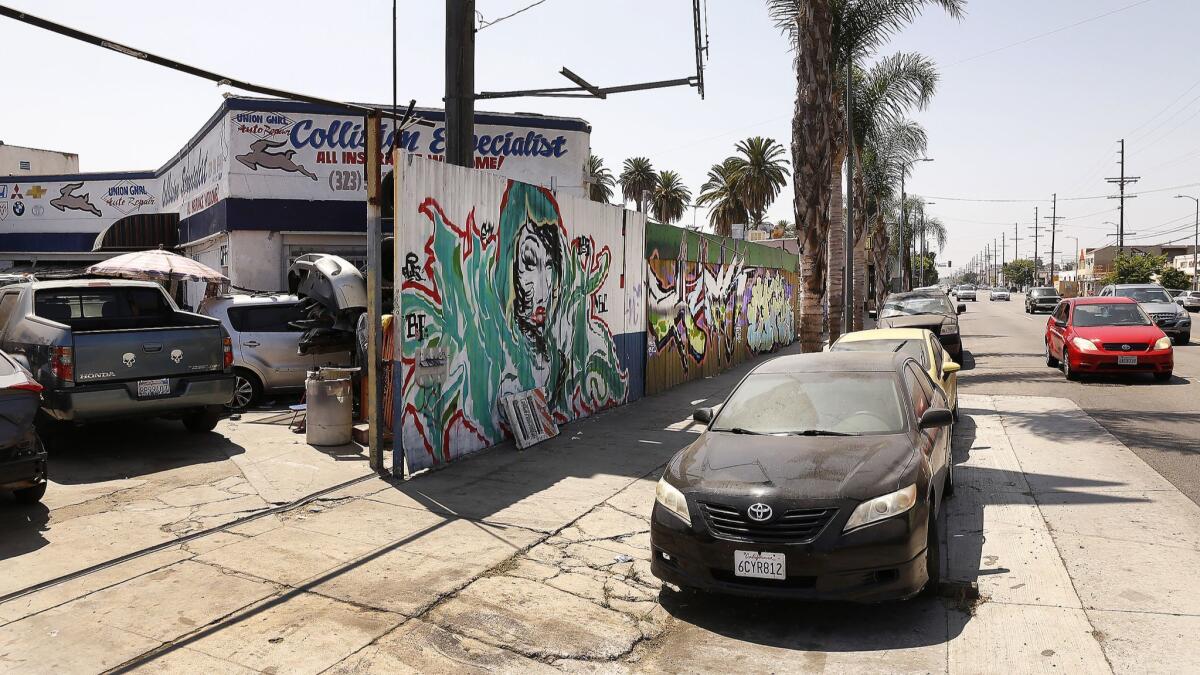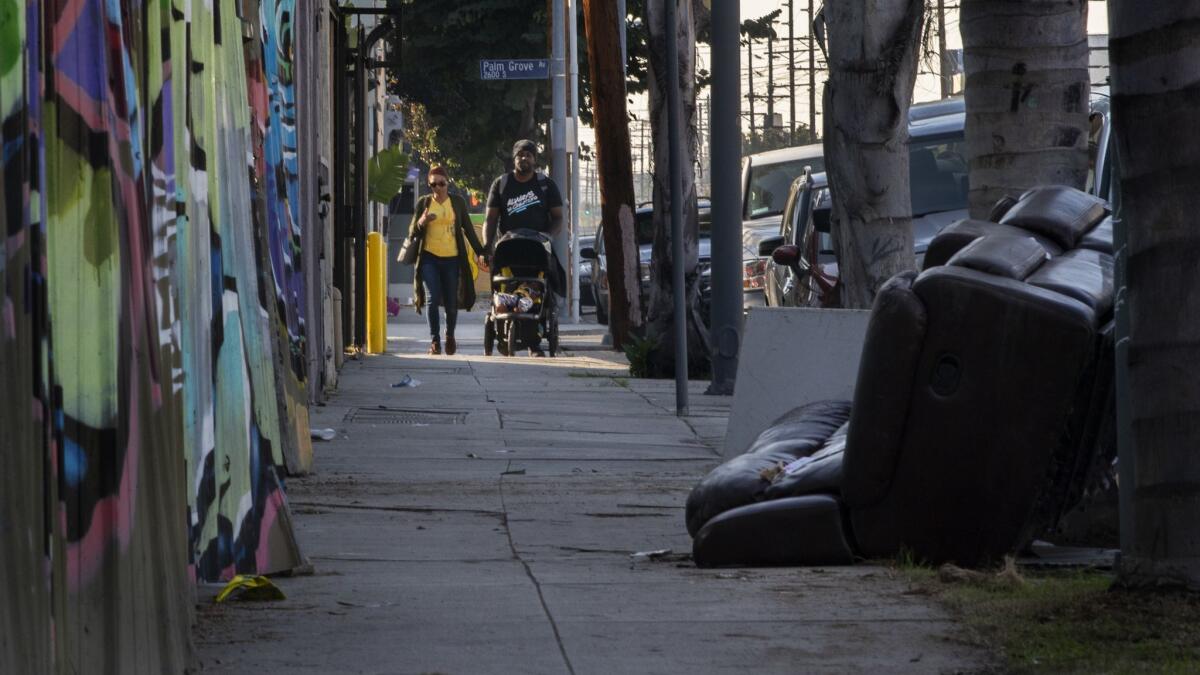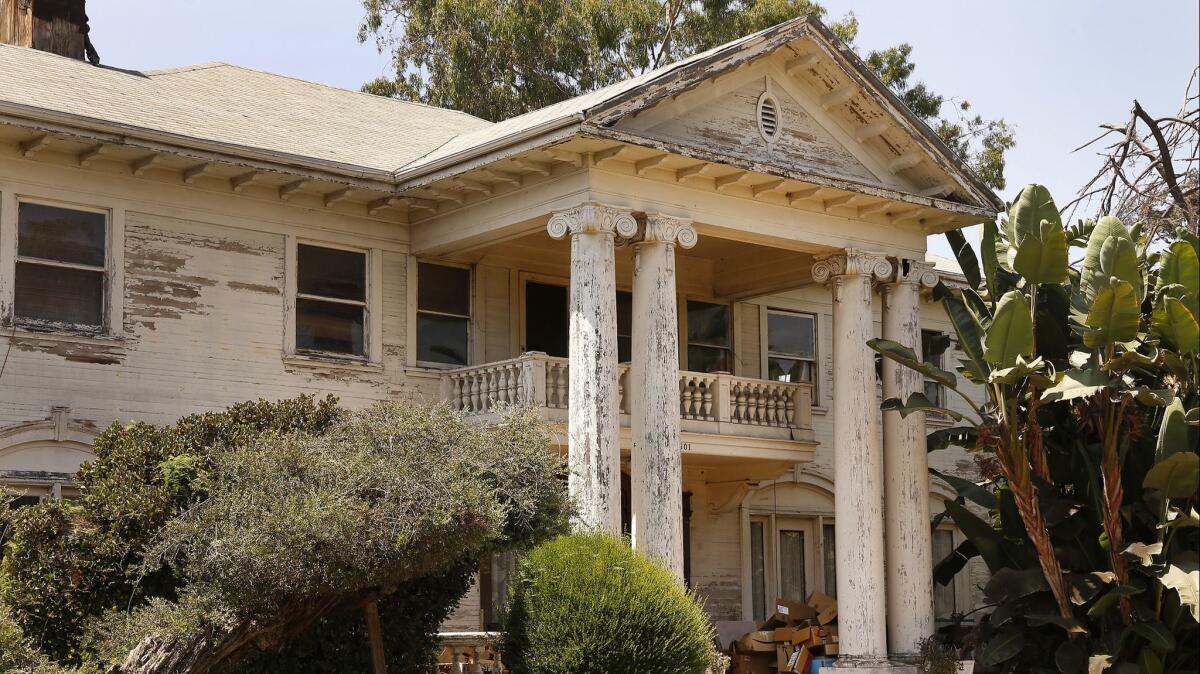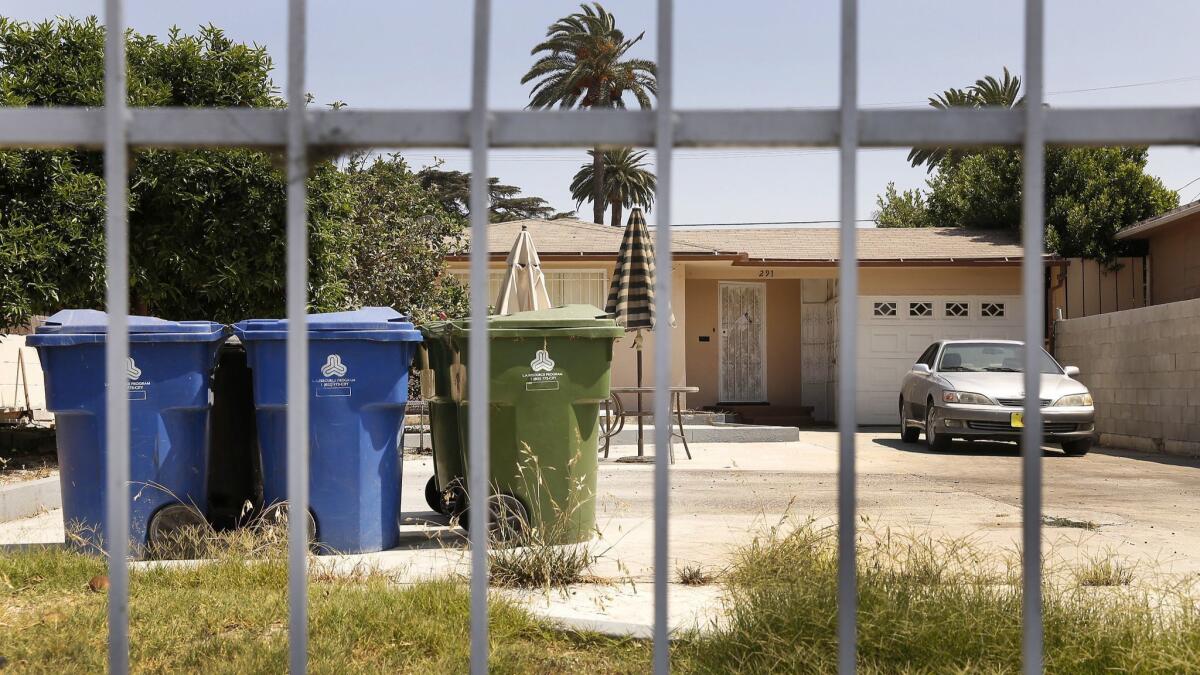Junk, blight and problem businesses: South L.A. residents fume over code enforcement

For more than a decade, complaints have rolled into the Department of Building and Safety about broken cars cluttering the street around an auto repair shop on West Adams Boulevard.
Again and again, Los Angeles city inspectors have ordered the shop to clean up its act.
And again and again, the problems have come back.
In February, the owner of Union General Auto Repair and the owner of the building were ordered — again — to stop leaving cars outside. Inspectors had already handed out more than a dozen orders to fix violations at the West Adams property, according to city records.
Antonio Diaz Partida, who operates the shop, argues that his business has been unfairly blamed for problems caused by several repair shops in the neighborhood. Yet residents say that despite the stack of orders from the city, little has changed at his shop.
“It’s so blatant, it’s unreal,” said Cheryl Johnson, a Jefferson Park resident who regularly drives past the shop on her way to visit family. “How can people live next to this?”
Pushing for better enforcement of parts of the Los Angeles Municipal Code — from addressing junky storefronts to cleaning up peeling paint — has become a mission for residents in this stretch of South Los Angeles, a gentrifying, racially and economically diverse neighborhood of stately mansions and Craftsman bungalows.
The Los Angeles Department of Building and Safety, which oversees such violations, said the West Adams shop is inspected annually under a city program that targets certain types of businesses, including repair shops and junkyards — one reason Union General Auto Repair has been cited so often. If problems are fixed each time, department spokesman Jeff Napier said, “there is no need to escalate enforcement.”
But Johnson and other residents say the perennial problems at the shop are an example of how the city has failed to aggressively confront junk and blight in their neighborhood.
Many have grown aggravated as they call in complaint after complaint and track problem businesses on spreadsheets. The neighborhood council has repeatedly met with the city building department to go over problem properties. One resident, Gage Tucker, compared it to having a second job.
“I go back and forth between thinking, ‘This is never going to get any better. I should just leave this neighborhood,’ and thinking, ‘I have to stay here and make a difference,’ ” he said.
Tucker got involved after he moved to the neighborhood and found that shop owners on nearby Venice Boulevard were cluttering the sidewalks with junk and wares: an old piano, a used sofa, an armada of office chairs. One shop in the building, which includes several businesses, was so stuffed with odds and ends that “you wouldn’t be able to open the door,” he said.
City records show that after an inspector slapped the building owner with an order to eliminate “pack rat” conditions in December 2017, code enforcement returned months later to find things had only gotten worse. In April 2018, the inspector found that “all the violations remain unabated.” Little changed, Tucker said, until the owner of the building evicted one of the shops last year.
Tucker still worries about other problems laid out by city inspectors nearly two years ago — including plaster tumbling from the ceiling and exposed electrical wiring — that cannot be solved by simply ejecting a business. As of early January, the Department of Building and Safety said that violations had yet to be fully resolved.
“These citations aren’t worth the paper they are written on,” Tucker said. “There are no consequences in our neighborhood. And the building owners know it.”

Complaints about code enforcement are not new. More than a decade ago, then-City Controller Laura Chick found in an audit that the Department of Building and Safety was relying on building owners to start following the rules voluntarily, allowing scofflaws to “repeatedly and consistently flout the law.”
Chick found that the department was inconsistent in imposing penalties for violating city rules and that, even when it did, the fines were often too low to make a difference. Very few cases were referred to the City Attorney, her audit noted.
Four years later, City Controller Wendy Greuel found that the building department had made many recommended improvements, such as coming up with policies for more consistent enforcement. But it still had thousands of orders for building and business owners to fix violations that had been outstanding for a year or more.
The Times analyzed city data on how code enforcement complaints were resolved across the city between 2011 and midway through 2018 and found that roughly 40% of complaints triggered a case. Almost 30% were deemed to be “no violation,” roughly 12.5% were deemed to be duplicates, and 17% were referred to other city departments or divisions.
In West Adams, residents point to properties that have generated years of complaints. More than a decade ago, the city ordered the owner of an aging home on 9th Avenue to tidy up its peeling paint. The department later discovered that rooms also had been added to the house without permits and deemed it “substandard.” When new complaints rolled in that the house looked “dangerous” and was a “blight” on the neighborhood, they were simply marked as duplicates.
Two years ago, the case was referred to city prosecutors, who gave the homeowner deadlines to take specific steps to remedy the situation, according to the building department. As of September 2018, the department said those deadlines had passed and it was preparing the case so that the City Attorney could weigh criminal charges.
But after part of the home was finally repainted, the department said it was holding off on pursuing a case. Napier, the building department spokesman, stressed that the homeowner was elderly and that the house is located in a historic zone, which “presents some added challenges” to completing the required work.
“We want to make sure we’ve exhausted all efforts to try to get compliance at the lowest level” before pushing charges, Napier said, adding later that the department is, “looking for substantial improvement by this spring.”
When asked why the work had gone so slowly, the homeowner — a UCLA program director — told The Times that it cost a lot of money and declined to comment further.

In some cases, West Adams residents complain that the city has concluded there is no violation despite serious complaints.
Two years ago, four people were killed in a gun battle at an eatery that was operating in the neighborhood without permission from the city. Residents said it was no secret that a neighbor was doing a brisk business in Jamaican food out of a house on Rimpau Boulevard, long before the gunshots made the cafe infamous. It even had online reviews, praising its jerk chicken and oxtails.
“You can get a beer while you wait to be served and service here is fast since they are always cooking,” one blogger wrote.
When a building inspector checked on a complaint about an illegal business a year and a half before the shooting, he found there was no violation. “Occupant/owner allowed full access to the house and all yards, front and back. House was not converted to a cafe,” inspection records state.
It is unclear exactly what time the inspector stopped by. Napier said the inspection likely occurred during normal business hours, from 7 a.m. to 4:30 p.m.
After the shooting, inspectors returned to the house in reaction to new complaints. One was unable to get inside. Two others returned later and “observed possible violations,” but said more research was needed before they could issue an order to resolve any violations. Later, inspections turned up nothing. One year after the shooting, when the house was sitting vacant, the city closed the case.
“If we don’t witness the violation,” Napier said, “we’re not able to take action.”

Los Angeles City Council President Herb Wesson, who represents the neighborhood, said his office was working directly with the department to address complaints.
“We’re the mouthpiece of the community,” he said. “So when the community has concerns, we have concerns.”
But Wesson said he had no specific proposals to change how code enforcement is handled.
Tucker said that talks with the city continue to be about specific properties.
“But we’re trying to have a bigger conversation than that,” he said. “We’re trying to understand what’s wrong with the system.”
Twitter: @AlpertReyes
More to Read
Sign up for Essential California
The most important California stories and recommendations in your inbox every morning.
You may occasionally receive promotional content from the Los Angeles Times.











